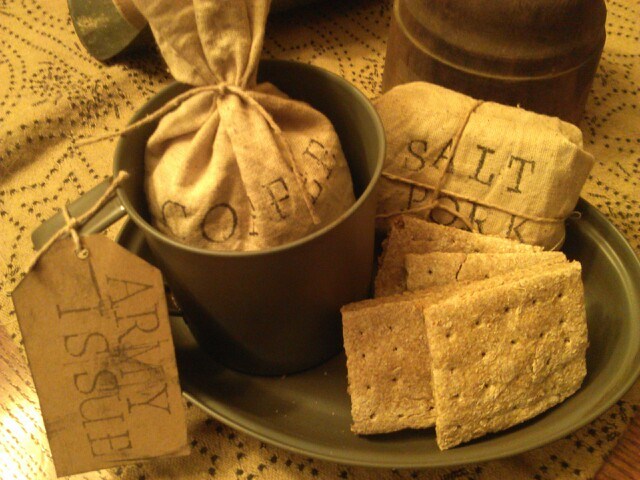Eating on the move is always a challenge – that is why having a good stock of easily accessible, easily consumed food as part of your survival stock is a must.
Here are a few suggestions for once your traditional on the trail food sources are consumed.
Pemmican
Pemmican is a great travel food that will store well for months in just paper, a full year if kept cool.
Pemmican is one of those well-known long-storage travel foods. The proteins and fats, and the precious calories from those fats, were hugely important to people who were in some ways very nomadic, and to those who might be largely sedentary, but whose opportunities for fats and meats came in very short bursts through the year.
By first separating very lean meats from fats, then processing those into the separate entities of dry beef and suet, they can be recombined into a travel food that will store well for months in just paper, a full year if kept cool. That food can then be eaten as-is, or used to make a soup.
Many, many modern pemmican recipes include “wet” dry fruits like raisins, craisins and currants – that’s going to significantly shorten the shelf life. A lot of the recipes I see floating around also include a lot of dried fruit, even though some of it is the dry-dry “leather” or “plastic” level of fruits. In some, there’s almost equal ratio of fruit to meat or fats.
Desiccated Vegetables
Mmm, sounds yummy, right? We’re not just talking dehydrated/dried veggies here. Desiccated vegetables are a combination of starchy veg and leafy root veggies, either minced and mixed up or layered, that are pressed under high pressure to remove moisture.
Most of the references to its use are from the Civil War here in the U.S. , with citation back to the Crimean War about fifty years earlier. It was highly recommended by the author of “Prairie Traveler” in the 1940s. There are sometimes mentions of it or similar-sounding ship’s food in naval journals from the same general pre-Antebellum period, where the cakes or planks of desiccated vegetables served the same purpose – providing much-needed vegetables to prevent scurvy in forces that were largely eating hardtack or similar foods for long periods of time.
Some recipes list the inclusion of beans or peas, most likely lentils and the starchier peas once grown far more widely. In all likelihood, these were collected green or were pre-soaked or cooked to soften, as opposed to pressed in as hard and dry legumes.
The mash that resulted was indented or separated into disks before drying, to allow for apportioning either on an individual basis, or by some accounts, into servings for four or five or eight souls.
Pocket Soup Still Going Strong
Erbswurst is compact rolls of five or six disks that dissolve into a pretty tasty and surprisingly textured lentil soup
I ran into Erbswurst while deployed in a multi-national force. They’re compact rolls of five or six disks that dissolve into a pretty tasty and surprisingly textured lentil soup (never add as much water as a soup manufacturer calls for). It does better if you bash it a couple of times to increase surface area, or you can stick it in some water and over a fire, and usually about the same time it starts simmering, it’s started to dissolve.
It’s tougher to find in the U.S. but as the internet shrinks our world, we can pay the shipping for it, or, we can look at similar soup options.
It might not be quite as compact, but we can absolutely portion out things likeBear Creek’s split pea soup when we’re ready to roll or from the get-go. Dr. McDougall has some of those instant cups and packets of split pea and barley that we can store for a good while or repackage for longer shelf life.
Trail Foods from History
There are a lot of reasons we might hit the trail and live out of a bag or off caches in the coming years. Pleasure packing, exploration, intelligence gathering, evacuations, hunting trips, relocation, travel for family reunions – they were done in all of the preceding centuries of recorded history, and they’ll continue to be done for the foreseeable future, no matter what it’s course. Happily, history provides a number of to keep us well-fed during our travels, things we can make at home now or later, and in some cases, readily available commercial options for the less DIY crowd.
In some cases, foods that were traditionally for the trail can also just give us a faster, easier meals – as we’re accustomed to – compared to preparing everything from scratch.
Historic trail foods also have another major benefit: They largely use heat at some point, but otherwise, there are few or no preservatives, and there is no need for fresh canning jar lids. That means if we’re running short of salt, sugar, vinegar, or pectin, or a pressure canner goes down, we still have viable means to get our foods from one harvest season to the next, just as some native tribes and northern explorers once did.
Of all the suggestions above, Pemmican sounds like the most palatable, although I am not sure the benefit of dried fruit outweighs the detriment of it going bad more quickly.
Regardless, you have options if modern on the trail food options are not available.
To see some other alternatives as well as instructions on how to make this various food, please visit The Prepper Journal.
Featured Image via The Prepper Journal

Stephanie J. Cykala things to study